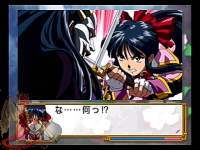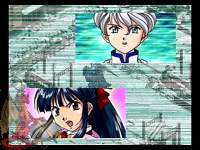|
|

|
BATTLE SYSTEM
|

|
INTERACTION
|

|
ORIGINALITY
|

|
STORY
|

|
MUSIC & SOUND
|

|
VISUALS
|

|
CHALLENGE
|
Light
|
COMPLETION TIME
|
~40 hours
|
|
OVERALL
5.0/5
|
Rating definitions
|
|
|
Sakura Wars is one of the premiere RPG series to never make it into English. Its OVA installments, movie, TV series, and ongoing manga have made it over the Pacific, but not the games upon which all of the offshoots have been based. In the regrettably enormous field of titles to be rejected for localization, Sakura Wars 2 is one of the best. The original Sakura Wars was incredibly good (with the caveat that one knows what type of game is being played before jumping in…) and its sequel is even better. To any RPGamer unafraid of playing a title with a great deal of Japanese text, this series cannot be recommended enough – and its pinnacle just might be the second installment (although Sakura Wars 3 has yet to be played by me!)
In the grossest generalization possible, Sakura Wars 2 is rather similar to its forebear in playing style. The player, assuming the role of Ohgami Ichiro, is the captain of the Teikokukagekidan. The Teikokukagekidan is both the Imperial Drama Troupe and the Imperial Fighting Troupe, thanks to a little sleight of wordplay in Japanese. And aside from Ohgami, all of its members are young women who are simultaneously actresses and fighters to protect the Japanese capital of Teito from evil. The game is divided into Episodes, akin to an anime series, and each Episode ends with a quick preview of the next to cement this resemblance. During an Episode Ohgami will interact with the inhabitants of the Teigeki (the opera house where all the Teikokukagekidan members reside, along with the other persons involved in this effort) in a fashion akin to an adventure game. With one exception, every Episode also features Shining Force or Fire Emblem-style Tactical combat against the enemy.
 This mask has no strings. Oni Ou is therefore quite disturbing. Also rather evil, as if that couldn’t be guessed.
This mask has no strings. Oni Ou is therefore quite disturbing. Also rather evil, as if that couldn’t be guessed.
|
|
The characters are considerably more important in this game series than in most others, so a proper introduction is in order. Returning from Sakura Wars 1 are all the major characters, save one. Shinguji Sakura is her sweet, slightly clumsy self. Kanzaki Sumire is, as before, the self-proclaimed ‘Top Star’ of the Teigeki, although she earns that title by always filling the seats. Maria Tachibana has mellowed a bit, but remains the most serious of the team. Iris Chateaubriand has grown a bit, but remains the youngest member of the Teikokukagekidan – although she tries not to act like it. Li Kohran is still her mechanically-inclined self, with inventions that like to explode. Kirishima Kanna likewise hasn’t deviated from her incredibly powerful, food-loving self. New to the Teikokukagekidan are Soletta Orihime, an Italian/Japanese woman with an avowed disapproval of Japanese men, and Leni Milchstrasse, a quiet German warrior. These eight are the fighting team Ohgami commands, and he himself is commanded by Yoneda Ikki, the nominal manager of the Teigeki, and the second-in-command, Fujieda Kaede – sister of Fujieda Ayame, the sole character from Sakura Wars 1 who does not return. Kasumi, Yuri and Tsubaki all return as the Kaze-Gumi (Wind Division) to help the Teikokukagekidan get from place to place and help run the Teigeki in the meanwhile. There is also the Bara-Gumi (Rose Division) who show up in Episode 5 – but the player should discover them for his/herself. The overall story deals with Ohgami returning to the Teikokukagekidan after a year’s absence and having to deal with a new foe trying to overturn the serenity of Teito….
The out-of-battle portions of the game play out rather as they did in Sakura Wars 1, but with some important additions. Ohgami will still be given several options to choose from in response to questions or comments from the girls, and his answers will either make the girl(s) in question trust him more or less. The questions are still timed, with silence being the result if an answer is not chosen – and silence being the best option from time to time. Now, however, questions can change from time to time; at certain points if the player waits until half of the allotted time has elapsed, some or all of the options will change – but they may become worse answers! There is also the addition of multiple timed questions within a larger time limit; a bar along the edge of the screen will tick away as the player struggles to achieve something within the overall time limitation, with multiple timed questions showing up separate from the larger timing issue. Another alteration is the insertion of a clock; Ohgami will have times when he is free to wander the theater, interacting with the characters, but he will usually have an event to attend, limiting his time to do this. Characters will be doing certain things at different times, and the player cannot catch all of them in any one play. As before, having the girls think highly of Ohgami translates into improved attack, defense, and movement in battle, along with garnering plenty of scenes that are unique to each girl as the game goes on.
In battle, any RPGamer with some Tactical experience will be instantly at home. All the Teikokukagekidan members use robots called Koubu to fight the enemy, with each member having a different specialty – Leni uses a lance and has pretty good range with it, Iris uses some bizarre telekinetic power that strikes everything around her, and Maria is a distance fighter who uses a pistol. A significant improvement from the first title is the ability to actually cancel a movement if the player judges it a poor one – in the first Sakura Wars once a character moved she was stuck there. Another improvement is the ability to recharge the energy used for special attacks; in the first the only way to regain this energy was to be struck by enemies. Ohgami can still protect any of the girls from attack, which is quite useful since it also causes him to rise in their esteem, but he can only use this ability thrice a battle instead of 8 times as in the first. Fighting is rather sped up this time, which is a welcome change to the slowly clanking Koubu of the first game. There is also the ability for any of the members to support each other if they are both in range of an enemy; one character’s attack may prompt another to join in for extra damage. Battles also are now clearly divided; the first phase frequently involves some objective other than mere comprehensive destruction of the enemy, and the player is frequently able to decide what course the battle will be fought towards prior to embarking upon it. After accomplishing whatever the battle’s goal is, the boss will enter for the second phase. Any RPGamer ought to know what the goal is when the boss enters the field….
 No – it is the long rumored union of German and Japanese militarism! Flat nations like Poland, beware!
No – it is the long rumored union of German and Japanese militarism! Flat nations like Poland, beware!
|
|
Many things that are somewhat standard in an RPG are absent from Sakura Wars. Experience, for one – there will be an upgrade to the Koubu eventually, but no actual experience. On the few occasions where Ohgami has a need for money, he will have the amount without any player input. Items organize themselves – upon acquiring something Ohgami will keep it until needed, without any player input beyond sometimes making the decision to take the item in the first place.
Visually Sakura Wars 2 is quite good without being extraordinary. Battles are not at the pinnacle of what the Saturn can achieve, except in the special attacks; these are prefaced by the character(s) launching the attack having a full-screen anime-style portrait with a quick battle taunt and the attack’s name. This looks better than it sounds. Bosses have their own special attacks in this vein. And Ohgami has two combined attacks with every other member of the Teikokukagekidan; one can only be accessed near the end if that girl is the one who feels best about him. Outside of battle the action is adventure-game style, with mostly still shots. These do look quite good however, showing off the game’s art budget: and there is FMV scattered about in sufficient quantity to be seen at least once an Episode.
Musically the game is superb. Kouhei Tanaka has done an even better job on this game than he did on the first, although the music is rather different than what is found in most other RPGs. There is quite a bit of variety, and the battle music is alternately delightful and menacing. The voice acting deserves commendation once more – all eight seiyuu for the Teikokukagekidan inhabit their characters precisely, with Okamoto Maya gaining special notice from me for actually having a distinct Italian accent in her speech. All other roles in the game have voice acting as well, well-done voice acting. Ohgami still does not speak outside of battle, which is odd when all the other characters are in the middle of a conversation and his lines are simply placed onto the screen – but he has a few utterances in battle, and they vary depending upon which partner he is teaming with for the grandiose special attacks.
Sakura Wars 2 has an involved story that, even if a player rushes through, will not be completed in much less than 40 hours. Incentive for replay is massive thanks to plentiful scenes that will be missed in the first or second plays as Ohgami wanders about interacting with the characters, and because in the last 4 Episodes there are a prodigious number of scenes that are specific to the girl Ohgami has the best relationship with; these are significant enough to ensure that seeing them all is worthwhile. Every girl also has her own ending, complete with her own self-performed theme song; should anyone dislike this notion, making it this far in the review is to be commended. Challenge lovers are again advised to abstain, because losing a battle in Sakura Wars 2 is not easy. Enemies do much less damage than the Koubu, and with their increased performance if the operator likes Ohgami more, losing is even harder.
The RPGamer craving relentless action is advised away from Sakura Wars in general. Also the RPGamer fearful of the large amounts of Japanese text, and the RPGamer with no interest in anything even resembling anime. All RPGamers who do not fall into these gross generalizations are herby exhorted to try a Sakura Wars game. These games are top sellers in Japan for a reason, and it is not thanks to payola.
Review Archives
|









